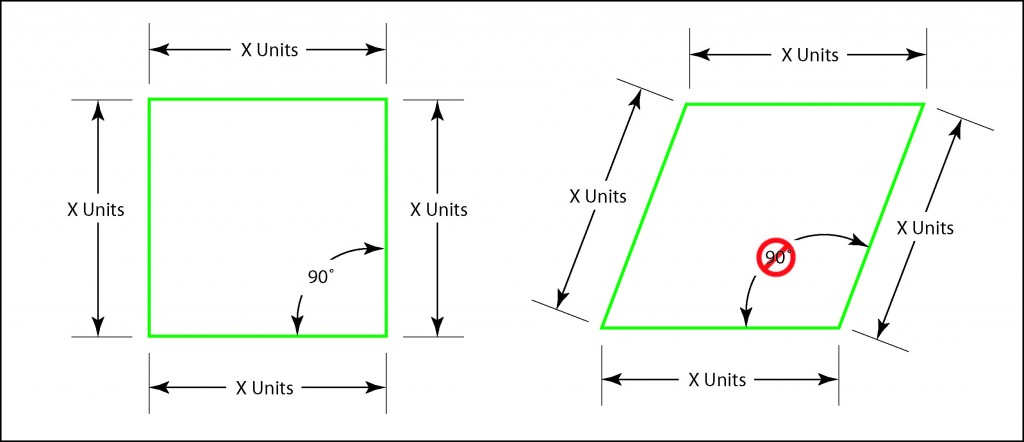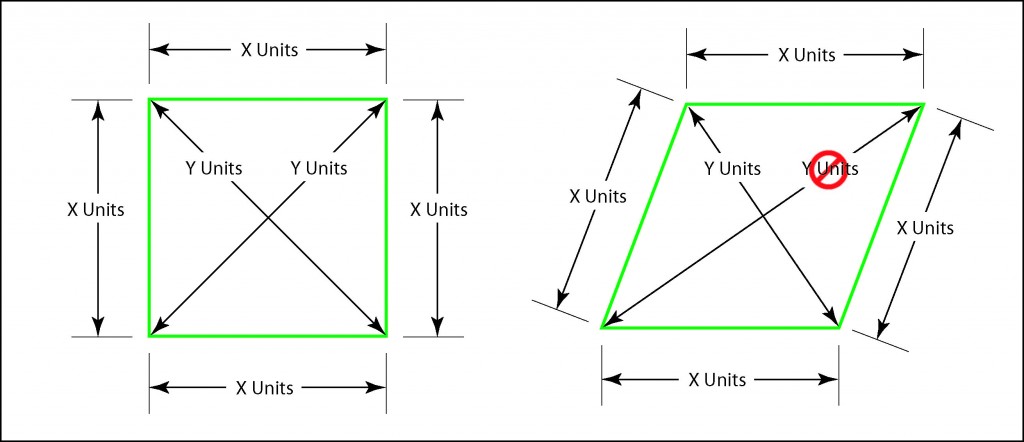At first it may sound like a “no-brainer,” but deciding what to measure can be a challenge. The first part of that challenge is determining what measurements are required to establish that a particular criteria has been met. The next is to determine if the tools required to perform the required measurements are available and, if not, how to assure that requirements are met using the tools that are available.
Let’s say, for example, that we need to determine the size of a metal plate and also determine if it is a square. We have at our disposal the capability to measure length using a tape measure but do not have the capability to measure angles. We know that a square is a shape defined as having four equal sides which are all straight lines. In addition, however, to be a square, that shape must have right angles at the corners. Measuring the four sides of our metal plate and finding them all of equal length does not allow us to conclude that the shape is a square because the corners might not be right angles.

Instead, the shape may be a parallelogram which meets that criteria for all sides being equal but does not meet the second requirement of the angles being right (or 90 degree) angles. Now, since we have the capability to measure lengths but no capability to measure angles we can not, on the basis of all sides being of equal length, be certain that the metal plate is a square without knowing the angles at the corners. With a little ingenuity (and even less math), however, we can determine if the plate is a square. We know that if an object is a square its diagonals must also be of equal length. We could use a little bit more difficult math and figure out what the length of the diagonal for a triangle with two equal sides of a particular length should be for the angle at their intersection to by a 90 degree angle. But there is an even more simple solution. The diagonals must be of equal length! So, by measuring the four sides and determining that they are all the same length and then the diagonals to assure that they are of equal length it is possible to meet our needs using only measurements of length.
In some cases, alternative means as described above can give more accurate measurements than those that would be considered immediately intuitive or “conventional.” In surveying land, for example, it is easy to measure length to a greater accuracy than it is to measure angles. Let’s say that a surveyor wants to mark out a plot of land that is 100 feet on a side and exactly square. Starting from a corner, the surveyor establishes a point exactly 100 feet away using a tape measure. The surveyor sights that point from the starting point using a transit (that telescope-like thing that surveyors use). The surveyor then turns the transit 90 degrees (the telescope is calibrated) to establish the line along which to measure the second 100 foot long side. A transit is a very precise instrument which is capable of measuring angles with reasonable accuracy but, unfortunately, a very small inaccuracy in measuring the angle will result in much amplified inaccuracy as the distance from the device is increased. Since measurements of distance are typically more accurate than measurements of angles, measuring the lengths of the diagonals will, in this case, likely result in the establishment of a more accurate plot of the land.
Interesting Sidelight – A neighbor of mine was recently in the process of laying a cement block foundation for a shed he had purchased. He knew the dimensions of the shed but also needed to assure that the foundation he was about to build had square corners. As an engineer, I saw this as a real challenge. I have a builders square but, surely, that would not accurately establish a reliably square corner as its longest arm is only about 2 feet in length and the shed was 10 feet by 12 feet. The neighbor, however, had an interesting and simple solution that he called the 3, 4, 5 rule. A triangle with sides with the length relationship of 3 units, 4 units and 5 units, defines a right angle at the intersection of the 3 and 4 unit long sides. This was a simple way to define his square corners which, being the engineer that I am, I had to verify using my equal diagonal rule as described above. The neat thing is that the units can be anything – inches, feet, meters, yards, miles . . .
There are many cases where the “obvious” measurements result in findings that are either less accurate than possible or that are just downright meaningless. Determining what parameters to use to achieve the required accuracy is critical to successful metrology.
– FJF –



 English
English Spanish
Spanish Chinese
Chinese Canada
Canada Mexico
Mexico United Kingdom
United Kingdom




